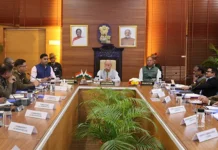Monday Musing
[ Nellie N Manpoong ]
At the very beginning of the pandemic, parents and guardians were reluctant to send their children to school, but after a complete year of shutdown of schools in 2020 and their staggered reopening towards the end of 2021, many have come to realize that children need schools to learn, to stay engaged, to grow, to build better relationships and just be children.
The new normal of online education has swerved into the direction of distance education and continues in many cities, towns and villages. Online education, even for children in cities, is tasking. As witnessed, teachers sometimes miss out on calling a child to present their class work as they sometimes fail to keep an eye on every child on different screens. At the same time, children too are not as attentive and take the opportunity to ignore the teacher, or are engaged in playing or doing other things during class.
It is all the more difficult for children in a state like Arunachal with lack of access to good internet connectivity and digital gadgets.
Amid the Covid surge, India entered 2022 with Covid-19 vaccines for children aged between 15 and 18 years, giving parents and guardians some comfort regarding the safety of their children from the virus. However, the turnout on the first day (3 January) in Arunachal painted a gloomy picture.
Only 1,785 of the total 98,003 target population of children received the vaccine in Arunachal, which means that the vaccination coverage on the first day was a mere 1.82 percent (rounded to 2 percent).
We need to factor in the delay in sending or receiving statistics and data, resulting in some districts reporting zero vaccination in the Covid bulletin, even though they had conducted vaccination drives on the day.
As per the bulletin, the highest turnout was in Dibang Valley district, where, of the 490 target population, 44 were vaccinated (9 percent). The capital region, which has the second highest population of 15-18 year olds (after Changlang) and likely more people who are educated and informed, had a mere one percent turnout, with only 118 of the estimated 8,305 children getting vaccinated.
There also seemed to be some confusion surrounding the vaccine’s name, the general eligibility criteria for children, and uncertainty regarding their identification and age proof documents, which may have attributed to the slow vaccination drive.
There have been announcements and advertisements that children aged between 15 and 18 years are eligible to receive the Bharat Biotech-developed Covid vaccine, Covaxin. But reports suggest that many uninformed people have been asking for Covishield for their children.
There is also confusion over whether the 18-year-olds are in the children’s category or the adult category.
It should be noted that the health ministry informed that those aged 18 and above (born in 2004 or before) are eligible for all vaccines, including Covishield.
Those aged 15-17 years (born in 2005, 2006, and 2007) are eligible only for Covaxin.
Even as the health department has announced that Aadhaar card or school ID, and in some cases any document that verifies the children’s age, will be accepted, some parents and guardians informed that children rarely have Aadhaar cards and some schools do not issue ID cards with the date of birth as such.
As we complete a week of the vaccination drive for children in the state, as of 9 January, West Siang district crossed the halfway mark with 52 percent and West Kameng is closing in with 47 percent coverage. While Kurung Kumey (2 percent) and Kamle (3 percent) have been slowly picking up pace, Kra Daadi has had only nine vaccinations, which does not account for even one percent of its total population of 3,325.
In an attempt to maximize vaccination coverage and achieve the government’s plan to complete the first dose of vaccination in 10 days’ time, the health department has also begun its Har School Dastak vaccination programme since 5 January in as many government and private schools as possible, and a total of 18,941 (19 percent) young people in the age group of 15 to 18 years were vaccinated till 9 January.
Although the vaccines seem to have helped most of us build a certain layer of protection against severe symptoms, it is difficult for anyone to predict what path the new Covid variants will take. Nobody wants their child to get ill; nobody wants a shutdown of schools and colleges; and certainly, nobody wants a lockdown.
Restrictions are inevitable for public health safety, but there has been public outcry in Italy and France, following orders such as barring unvaccinated people from accessing restaurants, shops, transport and other public activities. Dictatorial in nature, acquiring a vaccine pass cannot and should not be seen as the only way out as vaccinated people too continue to get infected.
There is no easy way out, but a simpler solution would include the oft-repeated slogan of health officials to “follow Covid-appropriate behaviour,” such as wearing a mask and maintaining hand hygiene.
Keeping everyone safe and satisfied at the same time seems like a double-edged sword for governments around the world now.





